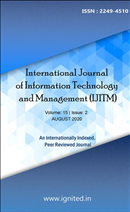A Study of the Employee Performance in Selected Banks and their Organizational Development
Main Article Content
Authors
Abstract
Banking is now referred to as innovative banking. in the banking and financial sectors,information technology have brought forth significant advances in product design and delivery. Their mainfocus is on providing excellent customer service and happiness. With the support of modern technology,the banking industry has launched a number of projects aimed at improving customer service. The primarygoal of this study is to investigate the influence of training on employee performance in the bankingbusiness, with the major focus on the meaning of a bank, the history of world banking, the types ofbanks, employee performance, and innovation in the banking industry
Downloads
Download data is not yet available.
Article Details
Section
Articles
References
- Jia- Fang L., Tjosvold, D.,&Shi, K. (2010). Team Training In China: Testing and Applying the Theory of Cooperation and Competition. Journal of Applied Social Psychology, 40(1), 101-134.
- Karakas, F. (2010). Spirituality and performance in organizations: A literature review. Journal of Business Ethics, 94(1), 89–106.
- Noe. R. A. (2010). Employee Training and Development. Fifth Edition. The Ohio State ,University. McGraw-Hill. Irwin
- Zikmund, W. G., Babin, B. J., Carr, J. C., & Griffin, M. (2010). Business research methods (8th Ed.). Mason, HO: Cengage Learning.
- Abbas, Q. (2009). Effect of leadership development on employee performance in Pakistan. Pakistan economic and social review: incorporating the Punjab University economist; bi-annual journal of the Department of Economics, University of the Punjab,
- Aguinis, H., &Kraiger, K. (2009). Benefits of training and development for individuals and teams, organizations, and society. Annual Review of Psychology, 60, 451-474.
- Nagar, V. (2009). Measuring Training Effectiveness. The Indian Journal of Commerce, 62 (4), 86-90.
- SanthanGopal K. S. (2009). Evaluation of medical college departments of ophthalmology in India. Indian journal of ophthalmology, 57(2), 159–160. https://doi.org/10.4103/0301-4738.45513 ,
- Dysvik, A., and Kuvaas, B. (2008). The relationship between perceived training opportunities, work motivation and employee outcomes. International Journal of Training and Development, 12(3), 138-157.
- Ramu. N. (2008). Human Resource Management in Cooperative Banks in India: Issues and Challenges. CAB Calling, 67-72.
- Shahzad K., Bashir, S., and Ramay, M. I. (2008). Impact of HR practices on the perceived performance of University teachers in Pakistan. International Review of Business, 4(2).
- Al Emadi, M. A. S., & Marquardt, M. J. (2007). Relationship between employees’ beliefs regarding training benefits and employees’ organisational commitment in a petroleum company in the State of Qatar. International Journal of Training and Development11 (1),

